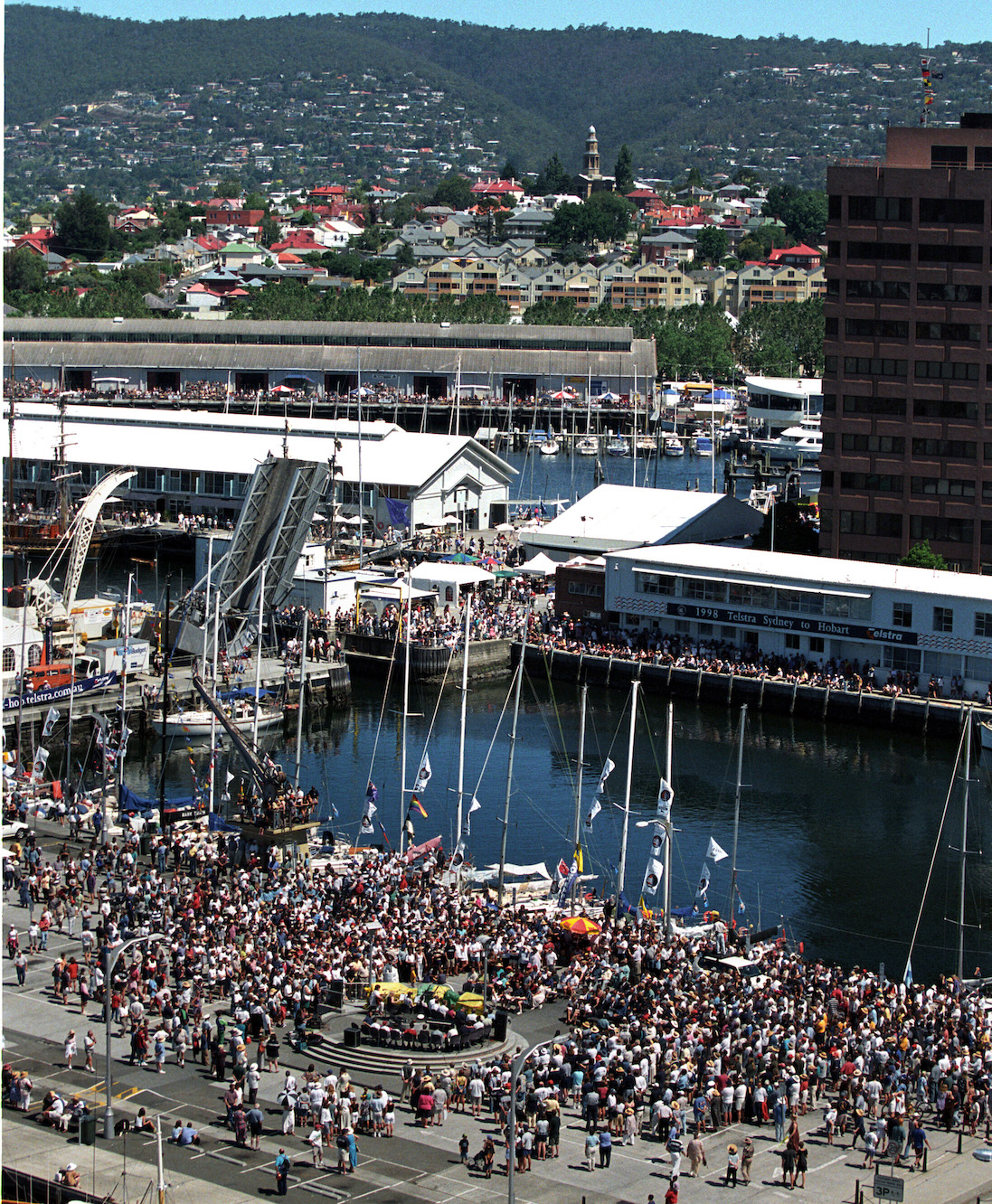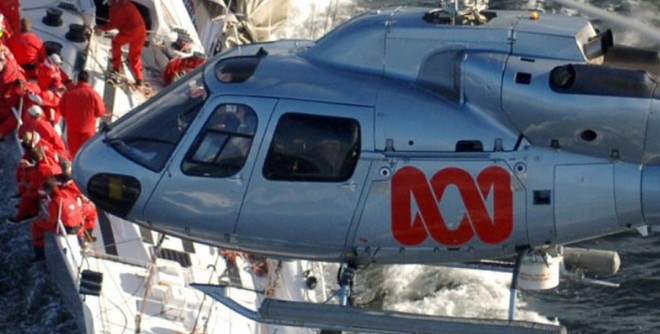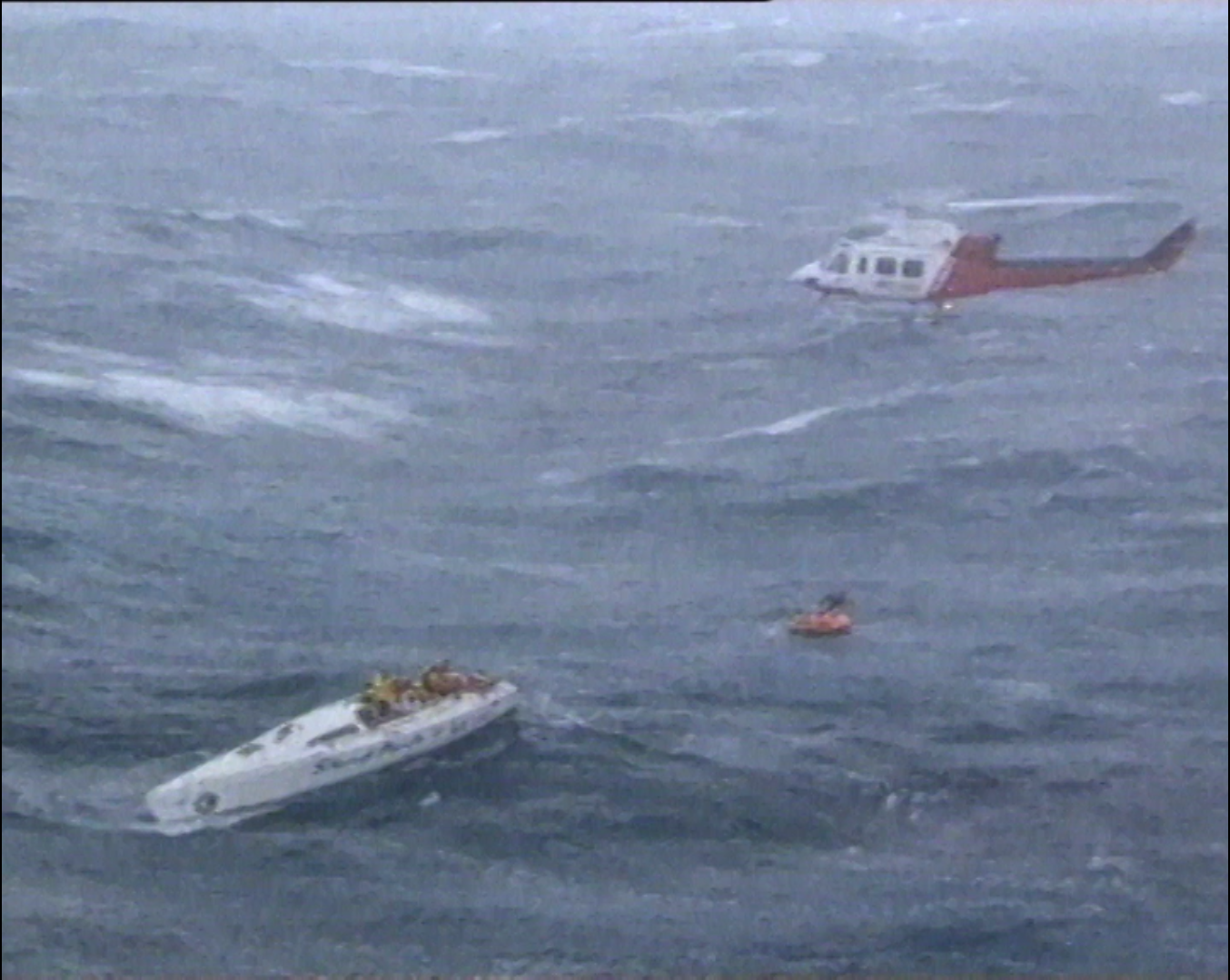Looking back
In a very special feature for this issue, Sails Editor Scott Alle recounts his experience covering the disastrous 1998 Sydney Hobart, as we commemorate 20 years.
21 December 2018
Advertisement
A great storm at sea irrevocably changes both those who survive it, and those who experience its myriad effects back on shore.
The devastating cyclonic cell that swept the 1998 Sydney Hobart fleet has continued to pervade the consciousness of all who witnessed its ferocity firsthand. None could have helped but be changed by what happened to them, their crewmates, and their fellow sailors.
In 1998, Sails Editor Scott Alle was assigned as the reporter in the ABC chopper that captured some of the most harrowing footage ever taken of an heroic sea rescue. It was, as he relates, a roller-coaster ride of emotions.
The year 1998 had been a busy one for me. My son Max was born in late June, and just a few weeks later, I was working in Papua New Guinea as the TV pool producer in the aftermath of a tidal wave that had wiped out villages on the north coast. The official death toll was 1,600, with 10,000 people made homeless, but as we flew over long stretches of twisted debris and picked through the remains of houses, it was obvious those figures were too low.
Advertisement
I interviewed a survivor who recounted how the people on the beach heard a loud boom and saw a large wave forming. (The three waves that crashed ashore were later estimated to be 10 –15 metres high.) His description of a roaring mountain of water closing in on its prey in the dead of night was eerily close to what injured yachtsmen would whisper to me five months later, as they were carried to waiting ambulances …
“The waves, mate, I’ll remember the waves,” croaked one exhausted survivor.
Thanks to the Boxing Day weather briefing at the CYCA, we knew conditions would be very tough for the 1998 Sydney Hobart. I’d sailed the race before in 1987, but was shocked by what we encountered in Bass Strait 24 hours later.
I was fortunate that my ABC colleagues covering the disaster were chopper pilot Gary Ticehurst, whose consummate skill in manoeuvring meant the twin-engine Squirrel traced a kind of aerial ballet above the boats, and cameraman Peter Sinclair whose rock-solid dependability was matched by an exceptional eye for the right shot. They worked unstintingly over the next three days. Gary fulfilled the unofficial but critical role of relaying the position of stricken yachts and reassuring crews that help was on the way.
After filing my report for the 7 pm ABC News bulletin on Boxing Day in Sydney, I jumped on a light plane to join Gary and Pete in Merimbula. We were usually based there for at least a day as we flew over the fleet, shooting vision and doing radio interviews that would be fed back to all the major networks and international news agencies.
On the way down, they had filmed Sayonara and Brindabella barrelling along neck and neck, surfing at over 20 knots – big speeds back then. From the chopper, they could see the front way to the south.
When Pete drew Gaz’s attention to it, his response was typically understated: “Tomorrow could be a big day. Better get an early night.”
They went out early without me to get the dawn shots and picked up vision of the early retirements including ABN AMRO Challenge, but by around midday we were above Helsal II as they battled 50-knot winds and seven-metre waves that lashed the boat.
On the way back to Mallacoota for refuelling, I remember asking Gary whether he’d seen conditions like this before –
green granite lines of swell marching toward a beach. “Nah, mate,” he replied quietly.
A police car drove onto the tiny strip at Mallacoota and an officer stepped out. He said there had been a mayday from a yacht. It was decided to ditch me to save weight so Gaz and Pete lost no time getting in the air and headed out to where Stand Aside was wallowing in 80-foot waves, with half its cabin roof gone and its crew injured. Pete rolled the door back and started filming.
He remembers it like this.
It was cold and wet. Not raining much, but there was loads of moisture in the air. After a while, the wind chill was crazy.
Basically Gary tried to keep the camera in the lee of the fuselage. While shooting,he kept the nose into the wind trying as best he could to power and drive the port side into the wind leaving the starboard side in the lee. This kept me and the camera as dry and affected less by the wind. Great in theory but impossible to anticipate the gusts and react instantly. Having said that, I was amazed by how smooth the ride was.
We had just a short period of relief from the elements. Time to rub the hands together, clean the lens, then open back up and do it again. I used my gloves to wipe the water from the lens – 1998 high-tech absorbent gloves that were soon saturated.
Perspective was difficult to gain that day. Surreal is the only way to describe it. The clouds were low and thick, so the light was flat. Whenever a wave top broke, the spume instantly marbled across the ocean surface.
After the (Winston Churchill) mayday call and the radio talk that followed, I dropped into a quiet space for a long time. I zipped up tight, warmed up and just watched the sea. I thought about the men on Winston Churchill, Stand Aside and the many others down there, somewhere, in the grey of the afternoon.
My thoughts turned to how as humans, we are so out of our natural environment, so beyond our comfort zone, when the sea is like that. It was then that just outside the door, directly in my field of vision, I saw a pod of maybe 10 dolphins in one of the many waves that Gary had estimated at 100 feet.
I watched as the dolphins left the wave exactly halfway between the trough and the peak: they were playing right where we’d been witnessing human disaster. Suddenly, amid all the desolation of the day, was the very thing my head had been searching for all day.
Perspective.
Peter Sinclair Former ABC Cameraman
I didn’t do much flying with Pete and Gaz over the next 24 hours. As the navy and civilian choppers deposited their cargo – battered, disoriented and painfully shocked victims of the carnage in Bass Strait – I tried to coax their stories out of them; convey the scope and quality of the massive rescue effort to an audience who were having difficulty understanding why a yacht race had suddenly turned so deadly.
Merimbula airfield was soon overflowing with all kinds of choppers and fixed-wing aircraft. Among them was the Royal Australian Navy’s Sea Hawk Tiger 70, which had been based in Nowra. They were the chopper crew tasked to lift sailors off the crippled Sword of Orion.
These days, Commander Marc Pavillard is the Executive Officer (XO) at HMAS Kuttabul, the navy’s historic base on Sydney Harbour. Back in 1998, he was a Lieutenant running the winch on Tiger 70 that had plucked five crewmen off Sword. Pavillard remembers there was a lot of trouble with the last of Sword’s crew, Carl Watson.
He couldn’t get his strop on. He was getting smacked by waves and he was losing the battle, spending more time underwater. I thought we might have to send the other air crewman Ox, Leading Seaman David Oxley, down the wire to sort it out but we needed to go as there was minimum fuel.
So we made a snap decision and lifted him 120 feet above the water. He was holding on under one armpit – hats off to him; superhuman strength. I understand he couldn’t use his hands properly for a few weeks because he was holding on so tight.
We got him into the cockpit and laid him down. He was hyperventilating and not in a good way. I thought he was having a heart attack. Ultimately, he just needed to catch his breath after his incredible ordeal.
As the door was closed, there was a moment of pure relief – and elation – as we headed back to Merimbula in white-out conditions. Then, just 15 minutes into the transit, it was like a curtain parted and beyond lay a clear sky. The water was blue; nothing like what we had been in. We couldn’t believe it.
It was obvious too, in the eyes of the sailors. They couldn’t believe that they’d just been through hell to find, on the other side, relative beauty and calm.
Commander Marc Pavillard RAN
Air Crewman, Sea Hawk Tiger 70
Back in Merimbula, the Sea Hawk’s maintenance guys gave the wire – which had been damaged during the rescues – a quick tug, a snap load. It parted. Pavillard agrees that it was unlikely to have lasted one more hoist.
The tragedy that overtook the Winston Churchill weighed particularly heavily on Gary’s mind. That now-famous distress call still sends shivers down the spine, and it worried him so much that later on in the motel room we checked on the tape to ascertain exactly what time it was recorded, and then attempted to work out where the ABC chopper was in relation to the fleet when the mayday came in.
Gary’s reasoning was that as the radio call was so clear and distinct, they must have been close – around 10 nautical miles. As Pete notes:
It was maybe 10 minutes since we had left Stand Aside and Careflight (the rescue chopper) with a couple of people still to be lifted. Our fuel was low; about 10 minutes’ reserve past our destination, which was a bit fine.
We slowed and peeled our eyes but saw nothing. It was late afternoon. There was talk over the radio of another (fixed-wing) aircraft identifying Winston Churchill in a location far from us, so we continued out of signal range to land and refuel.
Peter Sinclair Former ABC Cameraman
Once the immediate emergency had passed, we continued on to Hobart with very mixed emotions. We knew the race still had to be covered, but it was difficult to fly out over the sea each day knowing what had transpired and the terrible price paid.
But that was nothing compared to what sailors went through – like Sean Langman when the former round-the-world ketch Nokia was nearing the end of its ordeal by sea.
We didn’t realise people had perished until we got into the Derwent. People started checking their phones and the colour drained away from their faces.
When we docked, I did an interview with CNN and they asked, “How do you feel about continuing on when your friends are dying?”
I thought, that’s obviously a metaphor, but then they said there’d been fatalities. I felt ashamed at that moment. We went to Customs House for a drink, then I rang my dad who did two tours of Vietnam. I said, “I’ve just done a yacht race and I now know what you went through.”
Sean Langman
Managing Director, Noakes Group
(Helmsman, Nokia)
Advertisement
Advertisement
Advertisement





